Shiitake Dashi is a great option for vegans and vegetarians to use for Japanese soup stock. When you soak dried shiitake mushrooms for recipes, simply collect the liquid and repurpose it as an intense stock that’s packed with umami.
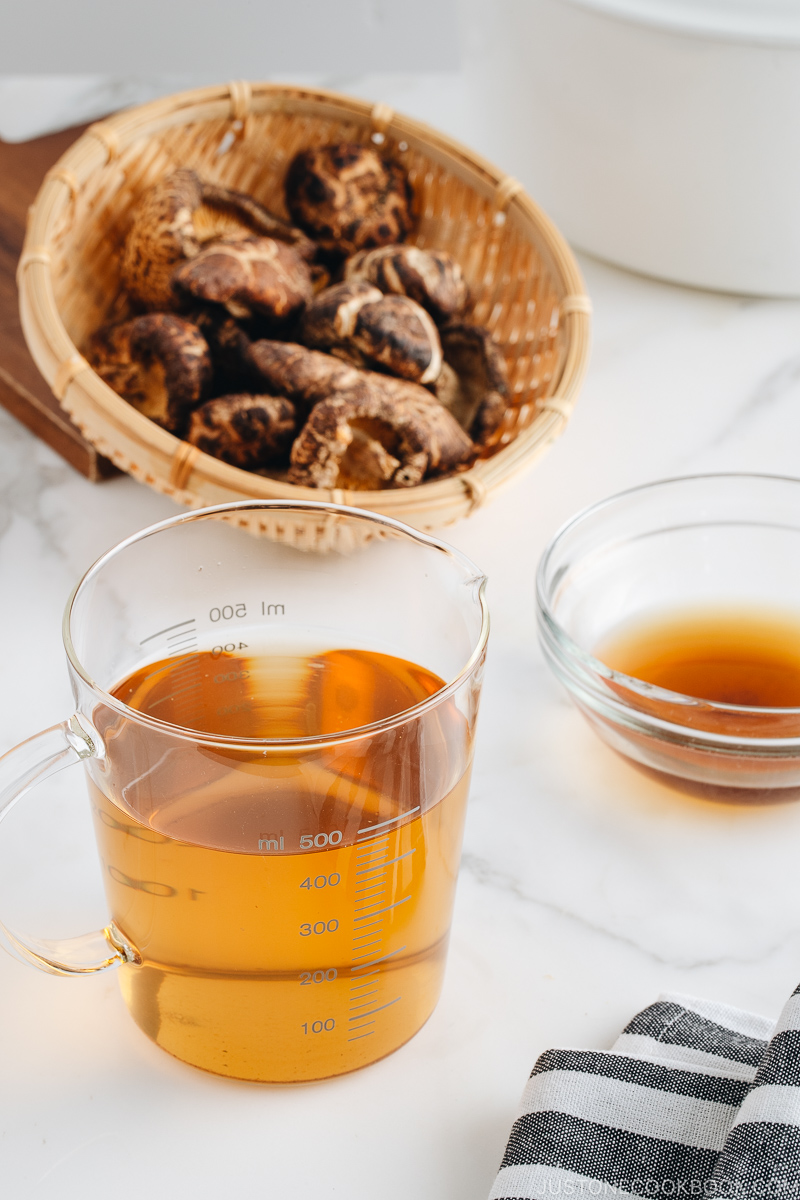
Dashi (Japanese soup stock) is a Japanese soup stock, and it is a fundamental ingredient in many Japanese dishes to create authentic flavor. Today I want to share how to make Shiitake Dashi (干し椎茸の戻し汁/椎茸のだし).
What is Shiitake Dashi?
Shittake Dashi (干し椎茸の戻し汁/椎茸のだし) is the liquid created from re-hydrating dried shiitake mushrooms in water.
As opposed to regular vegetable broth, we use Shiitake Dashi and Kombu Dashi as the only vegetarian and vegan dashi in Japanese cooking. These soup stocks allow you to cook authentic Japanese dishes without sacrificing the flavors.
In this post, I will show you how to re-hydrate dried shiitake mushrooms and make Shiitake Dashi for preparing food.

Shiitake Dashi for Vegetarians and Vegans
Shiitake Dashi is more of a by-product from rehydrating dried shiitake mushrooms with a small amount of water. Since the soaking liquid has good nutrients and flavors, we never throw it away and try to find a good use for it in cooking. We usually combine the liquid with other kinds of dashi to enhance the flavor and add umami; however, we rarely used shiitake dashi as its own.
Since I moved to the US, I learned that a lot of vegetarians and vegans here use diluted shiitake dashi (the soaking liquid) as a vegetarian/vegan-friendly stock in their Japanese cooking.
In Japan, Kombu Dashi is usually the only and most commonly used “vegetarian/vegan dashi” because shiitake dashi has an intense flavor that it could be too strong for subtle Japanese seasonings. However, if you enjoy the deep and rich shiitake dashi flavor, you can definitely use this soaking liquid as dashi to cook Japanese food.
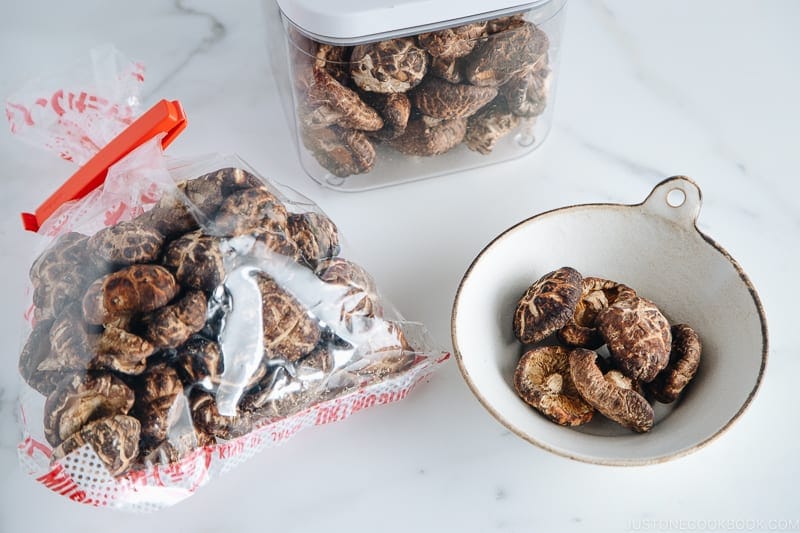
Tips to Get the Best Flavor from Dried Shiitake Mushrooms
Good dried shiitake mushrooms are expensive, but the flavors and texture are amazing. Oita prefecture (大分県) in the Kyushu region is known for the best quality dried shiitake mushrooms.
- Buy thick mushrooms with deep white fissures on the cap (more flavor).
- Use cold water to soak dried shiitake mushrooms to slowly bring out the flavor from mushrooms, preferably overnight.
To make shiitake dashi, please note that we can only use dried shiitake mushrooms because fresh shiitake mushrooms do not have the same deep and intense flavors as dried ones.

Japanese Soup Stock for Vegetarian Cooking
Shiitake dashi stores well in the refrigerator for 2-3 days and up to 1 month in the freezer, so you can prepare your stock ahead of time. Whenever you make miso soup or noodle soups, you will always have the dashi in hand.
Here are some vegetarian and vegan-friendly recipes with dashi that you may like to try:
- Vegetarian Ramen
- Vegan Miso Soup
- Spinach Ohitashi (Japanese Spinach Salad)
- Kenchinjiru (clear soup with root vegetables and tofu)
- Kitsune Udon
The Ultimate Dashi Guide
Dashi plays an important role as a flavor enhancer in Japanese cooking, so you don’t need to season the food with too much salt, fat, and sugar. Rich in minerals and other vitamins, dashi is considered a healthy ingredient in our daily diet.
There are six different types of dashi you can use in Japanese cooking, including vegetarian and vegan dashi (*).
- Awase Dashi – a stock made from a combination of dried kelp + bonito flakes
- Kombu Dashi * – a stock made from dried kelp
- Katsuo Dashi – a stock made from dried bonito flakes
- Iriko Dashi – a stock made from dried anchovies/sardines
- Shiitake Dashi * – a stock made from dried shiitake mushrooms
- Vegan Dashi * – a stock made from dried shiitake mushrooms and kombu
If you are new to different types of dashi, check out my Ultimate Dashi Guide.
Wish to learn more about Japanese cooking? Sign up for our free newsletter to receive cooking tips & recipe updates! And stay in touch with me on Facebook, Pinterest, YouTube, and Instagram.
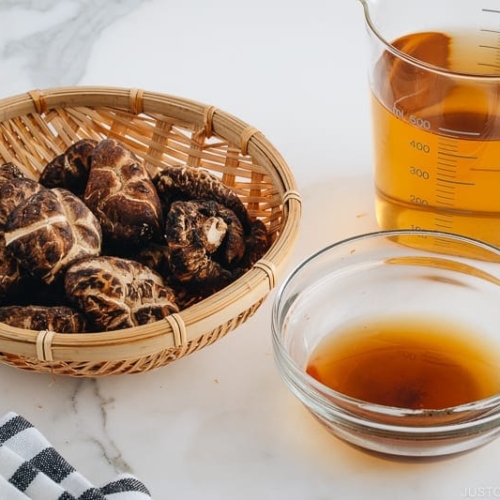
Shiitake Dashi
Video
Ingredients
For Rehydrating the Dried Shiitake and Collecting the Dashi
- 3 dried shiitake mushrooms (5–10 g each; found in Japanese and Asian grocery stores)
- ½–⅔ cup water (enough to cover the mushrooms)
For a Diluted Dashi
- 3 dried shiitake mushrooms (5–10 g each)
- 2 cups water
Instructions
Before You Start…
- In Japan, we collect shiitake dashi as a by-product of reconstituting dried shiitake mushrooms for recipes. We soak them only in just enough water to cover, so the resulting stock has a very strong and concentrated flavor. In this recipe, I‘ll show you two ways to rehydrate dried shiitake for either a typical stock or a diluted stock. Ideally, you want to start your dashi ahead of time and let it steep for a few hours or preferably overnight. Alternatively, I‘ll also show you a quick method that takes only 15 minutes of steeping time.
★ To Rehydrate the Dried Shiitake and Collect the Dashi ★
- Gather all the ingredients. Check the dried shiitake mushrooms to see if there is any dust or dirt trapped in the gills. If there is, use a pastry brush to clean it. Do not wash it under water.

- Place 3 dried shiitake mushrooms in a mason jar or airtight container and add ½–⅔ cup water (cold) to cover the mushrooms. Place a heavy object on top of the mushrooms to keep them submerged so they fully rehydrated. If you have time, let them soak in the refrigerator for a few hours or preferably overnight. If you are in a hurry, soak them in ½–⅔ cup warm water (body temperature) for 15 minutes or until softened.

- When the shiitake mushrooms are tender, squeeze to drain, reserving the liquid.

- Use the rehydrated shiitake mushrooms in the recipe of your choice. You can use them as you would fresh shiitake mushrooms. Simply remove and discard the tough stems with a knife.

- To collect the shiitake dashi, run the soaking liquid through a fine-mesh sieve to catch any dirt or debris. This concentrated Shiitake Dashi is now ready to use for adding to a sauce, steaming, seasoning, and so on.

To Store
- You can store the dashi in the refrigerator for 2–3 days or in the freezer for 1 month.

★ To Make a Diluted Shiitake Dashi ★
- Gather all the ingredients. Check if there is any dust or dirt trapped in the gills of the mushrooms. If there is, use a pastry brush to clean. Do not wash it under water.

- Soak 3 dried shiitake mushrooms in 2 cups water. Place a heavy object on top of the mushrooms to keep them submerged so they fully rehydrated. If you have time, let them soak in the refrigerator for a few hours or preferably overnight. If you’re in a hurry, soak them in 2 cups warm water for 15 minutes or until softened.

- After soaking for several hours…

- When the shiitake mushrooms are tender, squeeze to drain, reserving the liquid.

- Use the rehydrated shiitake mushrooms in the recipe of your choice. You can use them as you would fresh shiitake mushrooms. Simply remove and discard the tough stems with a knife.

- To collect the shiitake dashi, run the soaking liquid through a fine-mesh sieve. Your diluted Shiitake Dashi is now ready to use.

To Store
- You can store the dashi in the refrigerator for 2–3 days or in the freezer for 1 month.
Notes
Nutrition
Editor’s Note: This post was originally published in March 2015. The images and recipe have been updated in April 2019.
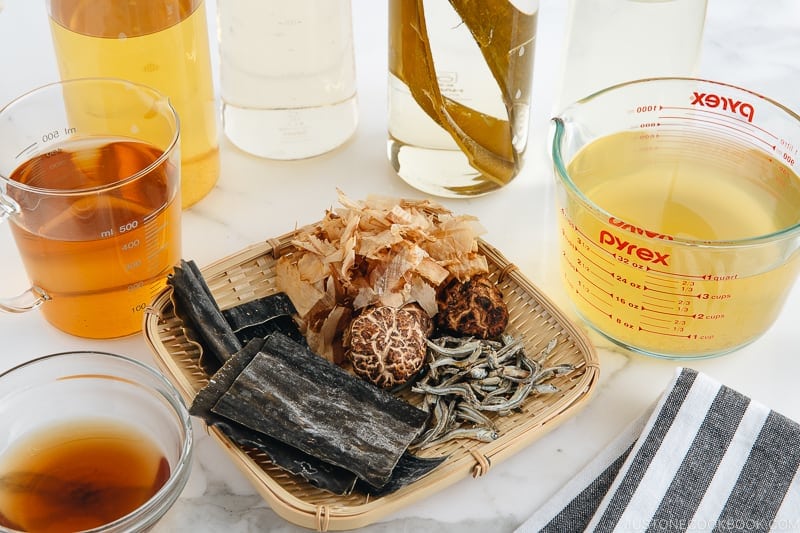
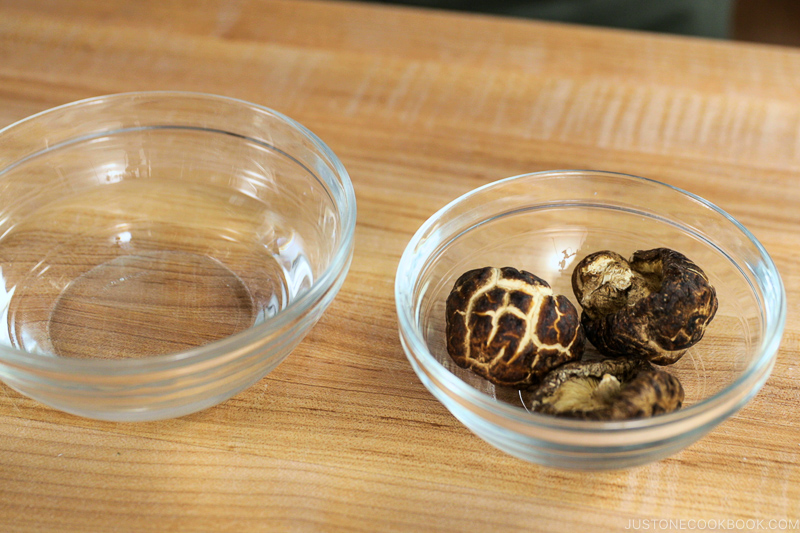
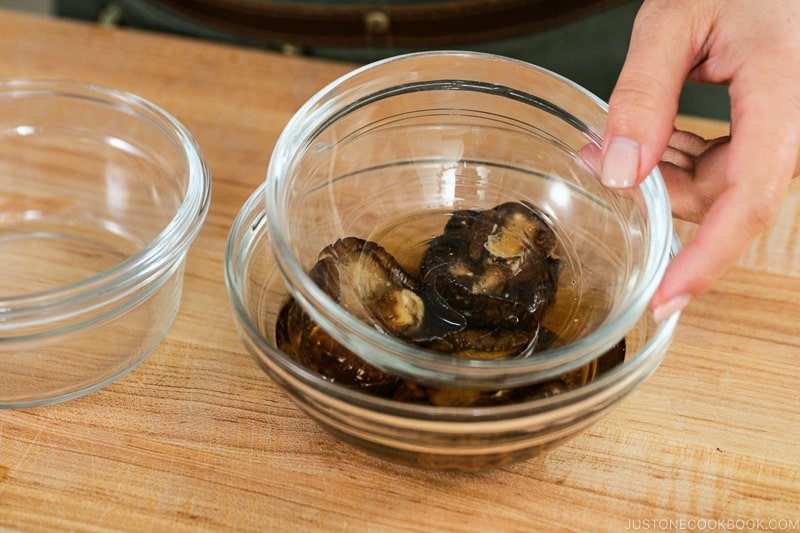

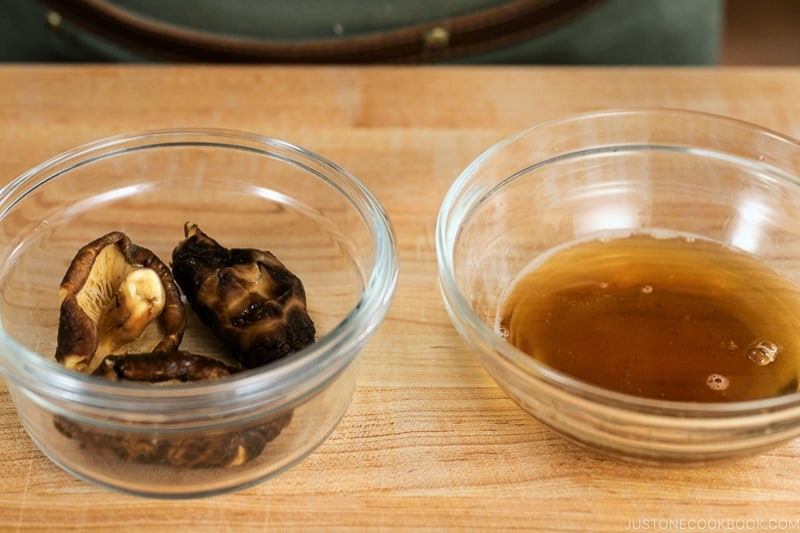
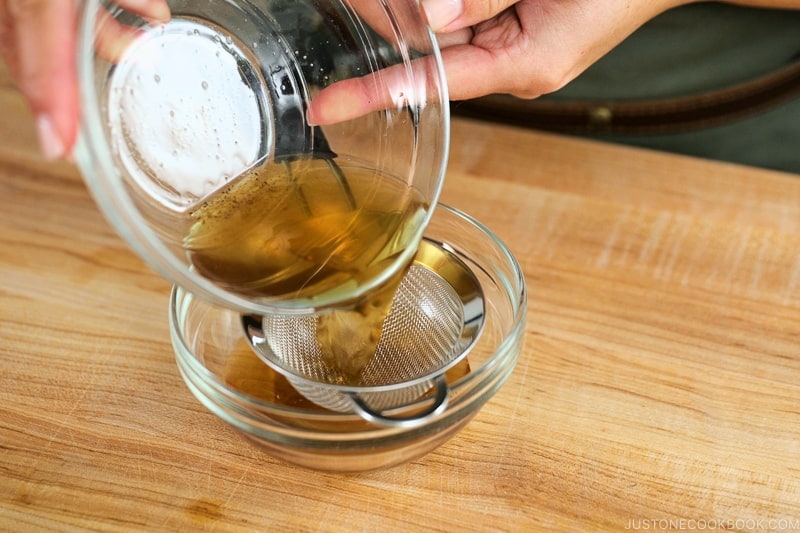
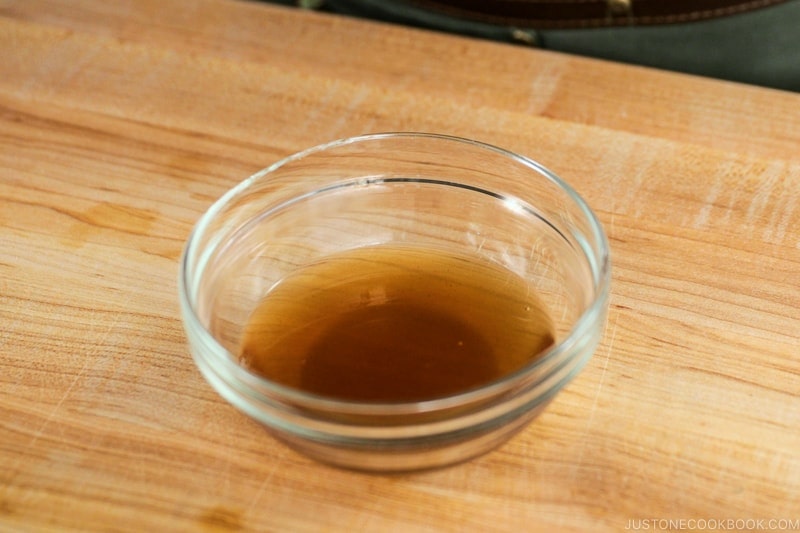

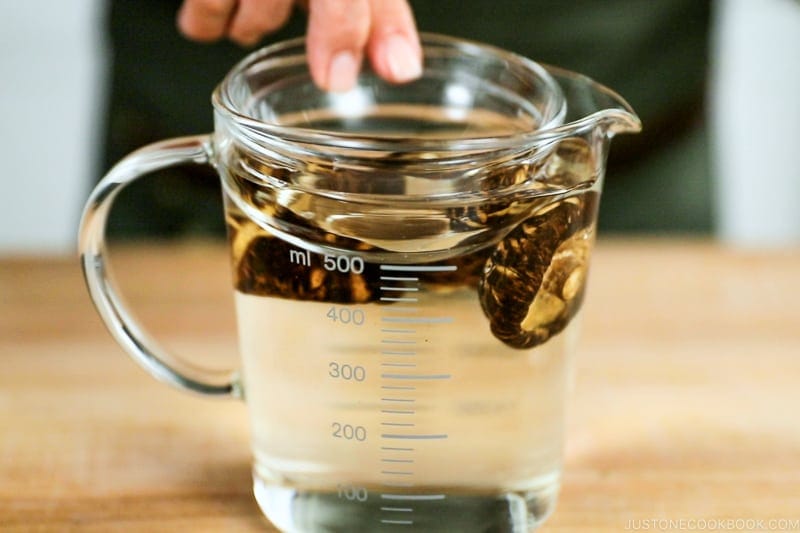
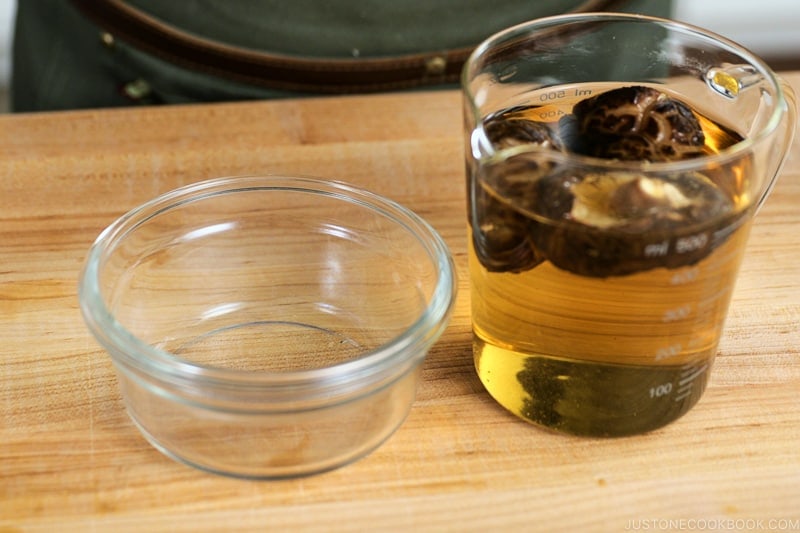

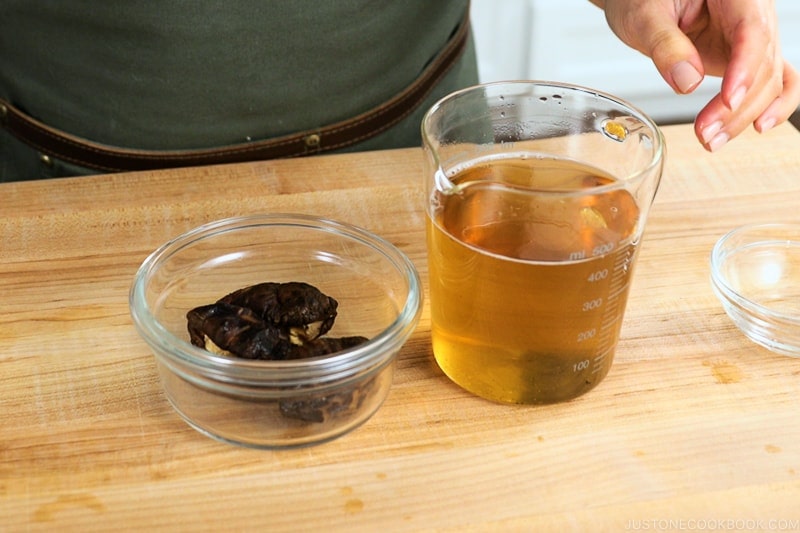
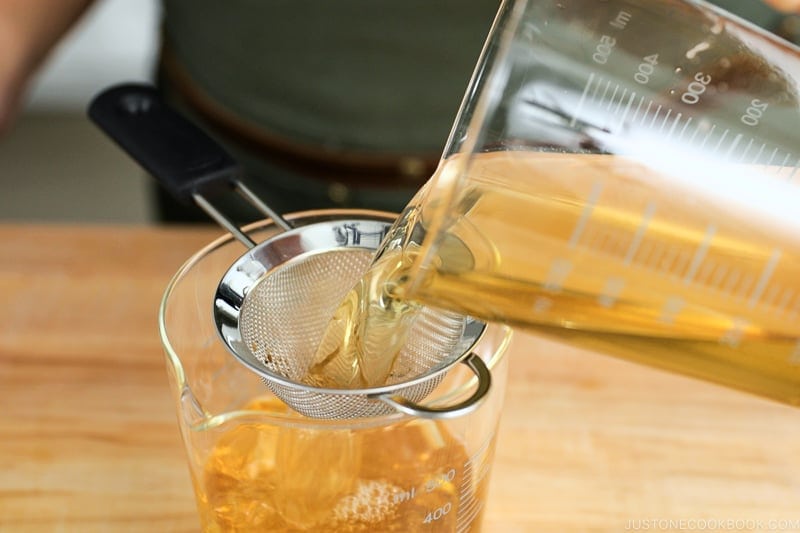










I do not understand why there are two recipes for this item. Are they separate Dashi?
Hi Joe! In Japan, we do not generally make standalone “Shiitake Dashi” like what I provided here. It’s not very common, because the flavor is too strong for classic Japanese dishes.
However, we do use the leftover liquid from rehydrating shiitake mushrooms. We often call this liquid “Shiitake no modoshi-jiru,” and use it to flavor some savory dishes. This is the standard usage with the remaining liquid after rehydrating. It’s considered wasteful to throw it away, so we utilize it, but the main ingredient is the hydrated shiitake.
Since the “shiitake dashi” seems like a popular dashi for vegans, I included it here.
Hope this helps! If I was vegan and trying to make dashi, I’d use Vegan Dashi, instead of standalone shiitake dashi.
https://www.justonecookbook.com/vegan-shiitake-kombu-dashi/